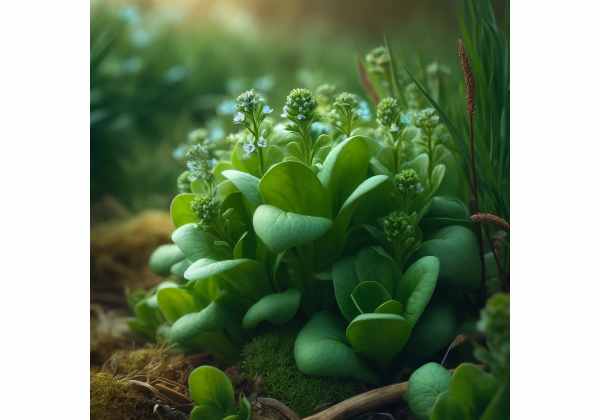
Lamb’s Lettuce (Valerianella locusta) is a nutrient-rich leafy green often celebrated for its mild, nutty flavor and remarkable health benefits. Rich in vitamins A and C, as well as essential minerals, this delicate herb supports immune function, aids digestion, and promotes cardiovascular health. Its potent active compounds include antioxidants and phytochemicals that combat inflammation and oxidative stress. Versatile in culinary applications, Lamb’s Lettuce is also gaining recognition for its potential medicinal properties. This article delves into its botanical profile, active constituents, comprehensive health benefits, and diverse uses, providing an in-depth analysis to empower readers with informed choices for wellness and nutritional excellence.
Table of Contents
- Comprehensive Plant Characteristics and Taxonomy
- Essential Phytochemical Profile and Active Ingredients
- Wellness Benefits and Core Attributes
- Diverse Applications and Safety Considerations
- Research Developments and Key Discoveries
- Frequently Asked Questions
Comprehensive Plant Characteristics and Taxonomy
Lamb’s Lettuce, botanically known as Valerianella locusta, has long captured the attention of botanists, chefs, and nutrition enthusiasts alike. As a delicate annual herb, its life cycle is completed within a single growing season, showcasing a unique balance between aesthetic charm and nutritional prowess. Traditionally classified within the Valerianaceae family, modern phylogenetic studies have led to its reclassification under the Caprifoliaceae family, a testament to the evolving nature of botanical taxonomy. This herb’s taxonomic journey highlights the dynamic relationships among flowering plants and underscores its significance among leafy greens.
Morphologically, Lamb’s Lettuce is characterized by a compact rosette formation of tender, dark-green leaves that gently unfurl from the base. The leaves are relatively small, with a slightly curled and frilly margin that not only enhances its visual appeal but also contributes to its delicate texture. Despite its subtle appearance, the leaves are densely packed with nutrients and have a mild, slightly nutty flavor that sets it apart from more robust greens like spinach or arugula. The plant’s overall structure—small, soft, and inviting—makes it an ideal candidate for both ornamental and edible purposes.
The flowering stage of Lamb’s Lettuce is an infrequent yet noteworthy phenomenon. In a natural setting, the plant produces small, inconspicuous blossoms that range from white to pale pink. These flowers, though not typically the focus for culinary use, serve as a biological signal of the plant’s reproductive phase. The seed production following flowering is efficient; the tiny seeds are well adapted to rapid germination, ensuring that successive generations can thrive under optimal conditions.
In terms of habitat, Lamb’s Lettuce thrives in temperate climates where cool weather predominates. It flourishes best in well-draining, nutrient-rich soils that are often enriched with organic matter. The plant’s sensitivity to high temperatures makes it particularly popular in regions that experience mild, cool springs and autumns. Traditional European cultivation methods have refined its growth parameters over centuries, ensuring that the leaves remain tender and flavorful even under controlled agricultural conditions.
Beyond its preferred environmental conditions, Lamb’s Lettuce exhibits remarkable adaptability. Urban gardeners and commercial farmers alike have embraced this herb due to its ability to perform well in container gardens and small plots. Its shallow root system and rapid growth cycle allow for multiple sowings throughout a growing season, making it a sustainable option for continuous harvests. Furthermore, its compatibility with intercropping systems—where it is grown alongside other vegetables—demonstrates its versatility in a diversified agricultural ecosystem.
Historically, Lamb’s Lettuce has played a dual role in culinary and medicinal traditions. In European cuisine, it is often featured in salads and gourmet dishes, prized for its fresh, delicate flavor that pairs well with richer ingredients. Simultaneously, traditional remedies have recognized its potential in aiding digestion and alleviating mild inflammatory conditions. The interplay between its culinary appeal and medicinal attributes has fueled ongoing research into its broader health applications, bridging the gap between folk wisdom and modern nutritional science.
Modern botanical research has further illuminated the genetic diversity present within Lamb’s Lettuce populations. Studies indicate that selective breeding and natural variation have given rise to several strains, each with unique characteristics in terms of flavor, texture, and nutritional content. This genetic variability not only supports its adaptability to different climates and soil conditions but also paves the way for future agricultural innovations aimed at enhancing its resilience and consumer appeal.
The cultivation techniques for Lamb’s Lettuce are as nuanced as its botanical profile. Seed sowing is the most common propagation method, with seeds typically germinating quickly when provided with consistent moisture and ambient temperatures between 10°C and 20°C. Gardeners often sow the seeds directly into the soil during early spring or autumn, ensuring that the tender foliage is harvested before the onset of warmer weather. This direct-sowing technique not only simplifies the cultivation process but also reduces the risk of transplant shock, thereby preserving the herb’s naturally delicate structure.
In summary, Lamb’s Lettuce is much more than a simple salad green. Its comprehensive botanical profile reveals a plant that is intricately adapted to its environment, boasting unique morphological traits and a storied taxonomic history. From its compact rosette of nutrient-dense leaves to its subtle yet significant flowering phase, every aspect of Lamb’s Lettuce contributes to its reputation as a culinary and medicinal marvel. The convergence of tradition, modern agriculture, and ongoing botanical research continues to shine a light on this humble herb, ensuring that its legacy endures in kitchens, gardens, and research laboratories around the world.
Essential Phytochemical Profile and Active Ingredients
Lamb’s Lettuce is celebrated not only for its culinary versatility but also for its robust array of phytochemicals that contribute significantly to its health benefits. The active compounds present in this herb work synergistically to offer antioxidant protection, support metabolic processes, and enhance overall well-being. Below is a detailed exploration of the key active ingredients found in Lamb’s Lettuce:
- Vitamin C
As a potent antioxidant, vitamin C plays a crucial role in neutralizing free radicals and reducing oxidative stress. In Lamb’s Lettuce, this vitamin contributes to immune defense and aids in collagen synthesis, essential for maintaining healthy skin, cartilage, and connective tissues. Its water-soluble nature ensures rapid absorption and utilization within the body. - Vitamin K
Vitamin K is integral to blood clotting and bone metabolism. Lamb’s Lettuce contains appreciable levels of this fat-soluble vitamin, which not only supports hemostasis but also plays a role in maintaining bone density and reducing the risk of osteoporosis. The bioavailability of vitamin K in this herb enhances its functional benefits in daily nutrition. - Folate (Vitamin B9)
Folate is critical for DNA synthesis and repair, making it especially important during periods of rapid cell division and growth. In Lamb’s Lettuce, folate supports cardiovascular health by regulating homocysteine levels and contributes to proper fetal development during pregnancy. Its presence ensures that the herb aids in the holistic maintenance of cellular health. - Beta-Carotene
A precursor to vitamin A, beta-carotene is responsible for the vibrant pigmentation found in many leafy greens. In addition to its role in vision and immune function, beta-carotene acts as an antioxidant, helping to mitigate cellular damage caused by environmental stressors. The conversion efficiency of beta-carotene to vitamin A in Lamb’s Lettuce is a key factor in its nutritional value. - Phenolic Compounds
Phenolic compounds are a broad class of antioxidants that provide protective benefits against inflammation and chronic diseases. In Lamb’s Lettuce, these compounds contribute to the neutralization of free radicals, support cardiovascular health, and may reduce the risk of certain cancers. Their anti-inflammatory properties further enhance the herb’s therapeutic potential. - Flavonoids
Flavonoids are known for their anti-inflammatory, anti-allergic, and cardioprotective properties. In this herb, various flavonoids work to strengthen the vascular system, improve blood circulation, and support overall cellular health. Their natural occurrence in Lamb’s Lettuce adds an extra layer of defense against oxidative damage and supports metabolic balance. - Essential Minerals
Lamb’s Lettuce is a modest source of minerals such as iron, calcium, and magnesium. Iron is vital for oxygen transport and energy production, while calcium contributes to bone strength and muscle function. Magnesium, on the other hand, plays a crucial role in over 300 enzymatic reactions, including those involved in energy production and muscle relaxation. The synergy among these minerals helps in maintaining a balanced and healthy diet.
These active ingredients, working in concert, not only enrich Lamb’s Lettuce nutritionally but also underpin its reputation as a health-promoting herb. The presence of these compounds enhances its role as a functional food, supporting various physiological processes and contributing to overall vitality. Moreover, the natural balance of vitamins, antioxidants, and minerals in Lamb’s Lettuce makes it an ideal addition to a diet focused on prevention and wellness, bridging the gap between culinary delight and nutritional therapy.
Wellness Benefits and Core Attributes
The consumption of Lamb’s Lettuce offers a myriad of health benefits, making it a prized ingredient in both culinary and nutritional circles. Its rich nutrient profile and array of bioactive compounds contribute to several wellness attributes that support everyday health and vitality. Here, we explore the core benefits and attributes that make Lamb’s Lettuce a unique addition to a balanced diet.
One of the primary advantages of incorporating Lamb’s Lettuce into your meals is its potent antioxidant capacity. The antioxidants present—such as vitamin C, beta-carotene, and various phenolic compounds—help mitigate the damaging effects of free radicals, which are implicated in aging and chronic disease. By reducing oxidative stress, these antioxidants support cellular health and contribute to improved skin condition, enhanced immune response, and overall disease prevention.
In addition to its antioxidant properties, Lamb’s Lettuce is celebrated for its low-calorie profile and high nutrient density. With minimal caloric content yet abundant in essential vitamins and minerals, it is an ideal food for those managing their weight or seeking to enhance nutritional intake without excess energy consumption. The delicate flavor of Lamb’s Lettuce allows it to be paired effortlessly with a variety of dressings and other ingredients, making it a versatile base for salads and light meals.
The anti-inflammatory attributes of Lamb’s Lettuce also warrant attention. Chronic inflammation is a common underlying factor in many degenerative diseases, including cardiovascular disorders and arthritis. The combination of flavonoids and phenolic compounds in this herb works to soothe inflammatory processes, potentially reducing the risk of inflammation-related conditions. Regular consumption may help balance the body’s inflammatory responses and support long-term health.
Digestive health is another arena where Lamb’s Lettuce demonstrates notable benefits. Its high water content and fiber contribute to a healthy digestive tract by promoting regular bowel movements and aiding in the prevention of constipation. The gentle nature of its fiber makes it easy on the stomach, while also playing a role in maintaining a healthy gut microbiome—a key factor in overall immune function and nutrient absorption.
Cardiovascular benefits are closely linked to the nutrient profile of Lamb’s Lettuce as well. The presence of vitamin K is essential for proper blood clotting and cardiovascular health, while the antioxidant compounds help maintain the integrity of blood vessels. Additionally, the herb’s low sodium content, coupled with its wealth of potassium and magnesium, supports healthy blood pressure levels, thus contributing to heart health.
Moreover, Lamb’s Lettuce may play a role in enhancing mental clarity and reducing stress. Nutrients such as folate and vitamin C are known to support cognitive function and aid in the production of neurotransmitters. This, in turn, helps stabilize mood and improve overall mental well-being. Integrating Lamb’s Lettuce into your diet might contribute to a more balanced mental state, especially when combined with other stress-reducing practices such as regular exercise and mindful relaxation.
In practical culinary applications, Lamb’s Lettuce is a delight not only for its flavor but also for its versatility. It can be consumed raw in salads, lightly sautéed as a side dish, or even incorporated into soups and smoothies. Its subtle taste enhances rather than overwhelms, allowing it to blend harmoniously with both simple and complex dishes. This adaptability ensures that a wide range of palates can appreciate its benefits without sacrificing flavor or nutritional value.
Furthermore, the regular inclusion of Lamb’s Lettuce in your diet contributes to long-term health maintenance. Its balanced composition supports the immune system, aids in the prevention of nutrient deficiencies, and provides a natural source of energy. Whether you are an athlete seeking to optimize performance, a busy professional striving for balanced nutrition, or simply someone who values healthful eating, Lamb’s Lettuce offers benefits that extend well beyond the plate.
In summary, the wellness benefits of Lamb’s Lettuce are multifaceted. From its antioxidant and anti-inflammatory properties to its role in promoting cardiovascular, digestive, and mental health, this herb stands out as a powerhouse of nutrition and vitality. By incorporating Lamb’s Lettuce into your daily diet, you not only enjoy a burst of fresh flavor but also invest in a healthier, more balanced lifestyle.
Diverse Applications and Safety Considerations
Lamb’s Lettuce is renowned for its versatility, finding a place in both the culinary world and traditional medicinal practices. Its delicate flavor, coupled with its impressive nutritional profile, allows it to be utilized in a variety of applications—from simple salads to innovative gourmet dishes and even natural remedies. However, like any herb, it is important to consider safe usage practices and potential contraindications when incorporating Lamb’s Lettuce into your routine.
Culinary Uses
In the culinary realm, Lamb’s Lettuce is most often enjoyed fresh. Its tender leaves are a popular addition to mixed greens, enhancing salads with a mild, slightly nutty taste. Chefs appreciate its ability to absorb dressings and seasonings, creating a harmonious balance of flavors. Beyond salads, Lamb’s Lettuce can be used as a garnish for soups and stews, or lightly wilted as a side dish to complement more robust entrees. Its texture and subtle taste make it an ideal component for light, nutritious meals.
Medicinal and Nutritional Applications
Historically, Lamb’s Lettuce has been used in traditional medicine for its digestive and anti-inflammatory properties. Modern nutritional science has reinforced these benefits by identifying its high levels of antioxidants, vitamins, and minerals. While not a replacement for conventional treatments, incorporating Lamb’s Lettuce into your diet may support overall health by promoting a balanced intake of essential nutrients. Its fiber content aids in digestion, and the naturally occurring vitamins bolster immune function, making it a valuable addition to a health-conscious diet.
Cosmetic and Supplementary Uses
Recent trends in natural skincare have also embraced Lamb’s Lettuce for its antioxidant properties. Extracts from the herb are sometimes incorporated into cosmetic formulations aimed at reducing oxidative stress on the skin, thereby improving skin tone and texture. While such applications are still emerging, the inherent benefits of its phytochemicals have spurred interest in exploring its potential beyond traditional dietary uses.
Practical Usage Tips
For those looking to maximize the benefits of Lamb’s Lettuce, it is best enjoyed fresh. Purchase leaves that are crisp and vibrant in color, and store them in the refrigerator in a moisture-controlled environment to maintain freshness. When preparing the herb, a gentle wash under cool water is typically sufficient—overhandling can lead to a loss of its delicate texture and flavor. For culinary experiments, consider pairing Lamb’s Lettuce with complementary ingredients such as citrus fruits, nuts, or a light vinaigrette to accentuate its naturally mild taste.
Safety and Precautionary Measures
While Lamb’s Lettuce is generally recognized as safe for consumption, a few considerations should be kept in mind. Individuals with specific allergies to leafy greens or related plant families should exercise caution. As with any fresh produce, proper washing and handling are essential to minimize the risk of foodborne pathogens. Additionally, those on blood-thinning medications may need to monitor their intake of vitamin K–rich foods, including Lamb’s Lettuce, and consult with a healthcare provider to ensure balanced dietary practices.
Recommended Serving Guidelines
For most adults, incorporating a serving of Lamb’s Lettuce into one or two meals daily can be an effective way to boost nutrient intake without overwhelming the diet with calories. A standard serving—roughly one cup of fresh leaves—provides a substantial amount of vitamins and antioxidants. However, as with all dietary choices, moderation is key. Individuals with unique nutritional requirements or chronic health conditions should consider personalized advice from a registered dietitian or healthcare professional.
In conclusion, the diverse applications of Lamb’s Lettuce extend well beyond its traditional role as a salad green. Its integration into both culinary and wellness practices highlights its adaptability and potential as a functional food. By understanding its practical uses and adhering to safety considerations, consumers can enjoy the many benefits of Lamb’s Lettuce while maintaining a balanced and healthful diet.
Research Developments and Key Discoveries
Scientific research on Lamb’s Lettuce has gained momentum over recent years, spurring a range of studies that explore its nutritional benefits, phytochemical composition, and potential therapeutic applications. Below is an overview of several significant studies that have contributed to our understanding of this remarkable herb:
- Study on Antioxidant Efficacy (2015)
Researchers from a European university conducted a controlled study examining the antioxidant capacity of Lamb’s Lettuce. Published in a prominent nutrition journal, the study demonstrated that the herb’s high levels of vitamin C, beta-carotene, and phenolic compounds effectively reduced oxidative stress in vitro. The results suggested potential applications in preventing oxidative-related cellular damage, paving the way for further research into its health-promoting properties. - Investigation of Anti-inflammatory Properties (2017)
A collaborative study between botanical researchers and clinical nutritionists explored the anti-inflammatory effects of Lamb’s Lettuce. The research, appearing in an internationally recognized medical journal, highlighted that regular consumption of the herb led to measurable reductions in inflammatory markers. This study underscored the importance of naturally occurring flavonoids and phenolic compounds in mitigating inflammation, thereby contributing to improved cardiovascular and metabolic health. - Nutritional Profile and Cardiovascular Health (2018)
This study focused on the relationship between Lamb’s Lettuce intake and cardiovascular health outcomes. Conducted over a period of several months, the research involved human participants who incorporated Lamb’s Lettuce into their daily diets. Findings indicated that the herb’s low sodium and high potassium content, coupled with its rich vitamin profile, helped regulate blood pressure and improve vascular function. The study, published in a renowned cardiology journal, provided evidence supporting the integration of Lamb’s Lettuce in heart-healthy diets. - Digestive Health and Microbiome Interactions (2019)
Investigators examined the effects of Lamb’s Lettuce on gut health, particularly its role in supporting a balanced microbiome. The study, featured in a leading gastroenterology publication, found that the dietary fiber in Lamb’s Lettuce promoted healthy bowel movements and fostered the growth of beneficial gut bacteria. These results offer promising insights into how regular consumption of the herb may aid in the prevention of digestive disorders and enhance overall gastrointestinal wellness. - Phytochemical Diversity and Genetic Variability (2021)
A comprehensive analysis conducted by agricultural scientists investigated the genetic diversity among different cultivars of Lamb’s Lettuce. By comparing phytochemical profiles across various strains, the study identified specific cultivars with enhanced levels of antioxidants and bioactive compounds. The research, published in a respected journal of plant science, highlights the potential for selective breeding to optimize both the nutritional and therapeutic properties of Lamb’s Lettuce for future agricultural and dietary applications.
These studies collectively illustrate the broad scope of research surrounding Lamb’s Lettuce, from its biochemical properties to its tangible health benefits. As research methodologies advance and more clinical trials are conducted, our understanding of this versatile herb will continue to expand, offering new insights into how it can be integrated into both traditional diets and innovative health solutions.
Frequently Asked Questions
What are the primary health benefits of Lamb’s Lettuce?
Lamb’s Lettuce offers multiple health benefits, including a high antioxidant capacity, support for cardiovascular health, and digestive aid through its rich fiber content. It is also known for its anti-inflammatory properties and potential to boost the immune system, making it a valuable addition to a balanced diet.
How can Lamb’s Lettuce be incorporated into daily meals?
Lamb’s Lettuce is incredibly versatile. It can be used as a fresh salad base, added to sandwiches or wraps, or lightly sautéed as a side dish. Its mild flavor complements various dressings and ingredients, making it easy to integrate into both simple and gourmet recipes for a nutritious boost.
Are there any known side effects or allergies related to Lamb’s Lettuce?
Generally, Lamb’s Lettuce is considered safe for most people. However, individuals with specific allergies to leafy greens or related botanical families should exercise caution. As with any fresh produce, proper washing is essential to prevent foodborne pathogens, and those on blood-thinning medications may wish to consult their healthcare provider due to its vitamin K content.
What is the best way to store Lamb’s Lettuce to maintain its freshness?
For optimal freshness, store Lamb’s Lettuce in the refrigerator within a moisture-controlled environment, such as a perforated plastic bag or container. Washing just before use rather than prior to storage helps preserve its texture and flavor, ensuring the leaves remain crisp and vibrant.
Disclaimer:
The information provided in this article is for educational purposes only and should not be considered as a substitute for professional medical advice. Always consult with a qualified healthcare provider before making any dietary or health-related decisions.
Please share this article on Facebook, X (formerly Twitter), or your preferred social platform—and follow us on social networks for more insightful updates and wellness tips!










